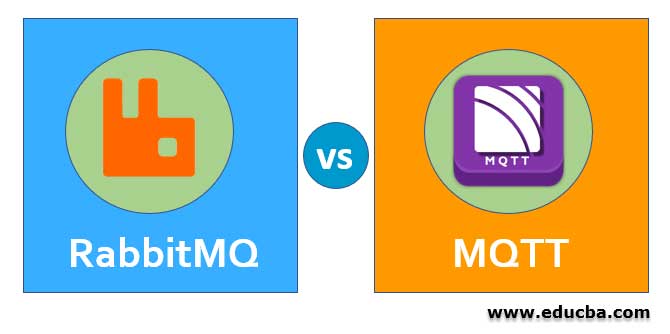Updated March 20, 2023

Difference Between RabbitMQ vs MQTT
RabbitMQ is one of the most widely used open-source message brokers. It was originally based on the Advanced Message Queuing Protocol (AMQP). Later on, it has been modified to support Message Queuing Telemetry Transport (MQTT), Streaming Text Oriented Messaging Protocol (STOMP), and several other common protocols.
Here we will discuss the top 7 differences between RabbitMQ vs MQTT.
MQTT is a lightweight pub-sub based messaging technology developed for IOT devices. It is used for communicating with remote devices (which have certain constraints) where network-bandwidth is costly. Facebook uses MQTT in their mobile applications.
Head to Head Comparison Between RabbitMQ vs MQTT (Infographics)
Below are the top 7 differences between RabbitMQ vs MQTT:
Key Differences Between RabbitMQ vs MQTT
Let us look at the key differences between RabbitMQ vs MQTT as below:
- MQTT is designed to be used for smaller devices that send messages over a network with low bandwidth. It is well-known for its simplicity (Only 5 Apis) and minimal wire footprint. On the other hand, RabbitMQ has been designed to be used for a variety of messaging scenarios that have developed over the last 25 years. It is well-known for Reliability and Interoperability. It has been implemented in many languages; therefore, it is one of the best choices for building reliable, large scale, clustered, resilient messaging infrastructure.
- MQTT supports only the pub-sub messaging technique. It is useful in cases where messages are short-lived, and there is active-routing of connected subscribers and publishers. Thus, it is troublesome to use MQTT for the classical long-lived messaging queues. On the other hand, RabbitMQ supports almost all the messaging forms like pub-sub, round-robin, message-queues, etc. It also supports message grouping and idempotent messages. It supports a lot of fine-grain control in terms of accessing queues. One can restrict access to certain queues, manage the depth and a lot more.
- MQTT doesn’t support transactions and allows some basic acknowledgements. RabbitMQ supports a variety of acknowledgements for different use cases and supports transactions across messaging queues. It also allows segregation of the various transactional semantics (if required). It also allows distributed transactions like X/Open XA transactions.
- MQTT doesn’t come equipped with any security protocol out of the box. Thus, we need to spend additional time/resources in order to integrate any security protocol. RabbitMQ has some significant advantages over MQTT in terms of connection security. It comes out of the box with support for SASL, TLS and the IETF set of RFCs. It also has updated itself to support modern SASL mechanisms, like GS2 and SCRAM-SHA.
- In real-life scenarios, we would need the reliability and advanced features of AMQP and the capability to work with low power devices on smaller bandwidth networks. RabbitMQ is perfectly suited for such cases as it is capable of using AMQP and MQTT together.
RabbitMQ vs MQTT Comparison Table
Let’s discuss the top comparison between RabbitMQ vs MQTT:
|
RabbitMQ |
MQTT |
| Designed as a general-purpose messaging protocol that can be used for message-oriented middleware and for peer-to-peer data transfer. It has been adopted by many big companies/organizations like JP Morgan, NASA (for Nebula Cloud Computing) and Google. In fact, it also finds usage in India’s Aadhar Project, which is the largest biometric database in the world. | Designed for IOT devices. Ideal for remote low power devices sending messages over a bandwidth-constrained network. In fact, Facebook uses it because it draws lesser power and is lighter on the bandwidth. |
| It supports powerful message routing. It is useful when we need to run the same job on a specific server, group of servers or all servers. The application sends one message, and exchange will route it. | It doesn’t support complex message routing. |
| Not wire-efficient and requires more effort for implementing on a client. In order to publish messages to a node, the first step is to establish a link, then enable flow over that link and finally send the messages. | It is wire-efficient, and the efforts for implementing on a client are lesser. |
| It supports both points to point and pub-sub messaging techniques. | It supports only the pub-sub messaging technique. It doesn’t support message queues. |
| It implements SASL mechanisms, thereby enabling users to choose the security they want to (E.g. Kerberos v5) without changing the protocol. It also supports proxy security servers, therefore allowing organizations to use nested firewalls, gatekeepers, etc. | In terms of user security, it allows short passwords and usernames that don’t provide enough security in the modern world. In case of any policy change or security weakness, it would require a new version of the protocol. |
| It doesn’t support LVQs out of the box. | It supports Last-Value-Queues (LVQs), which allows a new Consumer to skip previous messages, get the latest ones and then receive updates on the same. A typical use case would be stock prices, where one would be interested in the latest values. |
| It can have multiple message namespaces, and each of them supports different ways of finding messages. | Its only message namespace is a topic, and all messages will go into it. |
Conclusion
Both RabbitMQ and MQTT are popular and widely used in the industry. You would prefer RabbitMQ when there is a requirement for complex routing, but you would prefer MQTT if you are building an IOT application. For larger systems, you would probably use a combination of the two so that you can utilize the benefits of both.
Recommended Articles
This is a guide to RabbitMQ vs MQTT. Here we discuss the RabbitMQ vs MQTT key differences with infographics and comparison table, respectively. You can also go through our other suggested articles to learn more –


